보통 사마귀(심상성 사마귀), Common warts(Verruca vulgaris)
보통 사마귀(심상성 사마귀)의 개요
- 여러 종류의 사마귀 중 가장 흔한 사마귀는 보통 사마귀이다.
- 보통 사마귀는 얼굴, 손, 손가락, 손톱 주위, 발가락, 팔꿈치, 무릎 등에 잘 난다.
- 보통 사마귀는 좁쌀만 한 것도 있고, 메주 콩알만 한 것도 있다.
- 더 큰 사마귀의 직경은 몇 cm이다.
- 보통 사마귀는 피부에 생긴 바이러스성 감염병이다.
- 보통 사마귀를 심상성 사마귀라고도 한다.
보통 사마귀(심상성 사마귀)의 증상 징후
- 보통 사마귀가 난 피부 부위, 보통 사마귀의 수, 합병증의 유무 등에 따라 증상 징후가 다르다.
- 사마귀가 난 손톱 주위나 발바닥 주위가 아플 수 있다.
- 그 외 신체 부위에 난 보통 사마귀의 대부분은 보기가 흉할 뿐 별다른 증상 징후가 없지만, 거치적거리고 좀 가려울 수 있다.
- 보통 사마귀를 일으킨 바이러스에 자가 감염이 될 수 있다. 보통 사마귀가 선상으로 날 수도 있고 여러 개가 한 부위에 무더기로 날 수 있고 한 개만 나 있을 수 있고 플라크(판형) 형태로 날 수 있다.
- 보통 사마귀를 손톱으로 잡아 뜯거나 사마귀가 어디에 마찰되어 사마귀에 상처가 나면 좀 아플 수 있다.
- 박테리아 감염이 사마귀에 생기면 사마귀와 그 주위가 곪을 수 있다.
- 보통 사마귀가 손톱 주위에 나면 사마귀의 가장자리와 그 주위의 정상 피부의 경계가 확실치 않고, 손톱 밑 속으로 자라 들어 갈 수 있고 그 손톱 밑이 아플 수 있다. 이런 사마귀를 손톱주위 사마귀 또는 조갑주위 우췌라고 한다.
- 발바닥에 사마귀가 날 때는 사마귀가 난 발바닥 부위가 아플 수 있다.
- 특히 사마귀가 난 발로 걸을 때 발바닥에 난 사마귀의 바로 밑에 있는 피부층하에 있는 발 말초 신경이 사마귀 덩어리로 눌리기 때문에 걸을 때 발바닥이 아플 수 있다.
- 이렇게 발바닥에 난 사마귀를 족저 사마귀, 또는 족척 우췌라 하고 보통 사마귀와 다른 점이 있다.
- 보통 사마귀를 일으킨 바이러스가 핏속으로 감염되지 않고 신체의 다른 부위에 아무런 병도 일으키지는 않는다.
- 보통 사마귀가 주위에 있는 피부에 직접 닿아 그 주위 피부에 퍼져서 자가 감염이 생기고 새 보통 사마귀가 날 수 있다.
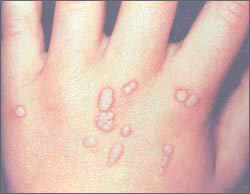
사진 435. 손등에 난 보통 사마귀
Copyright ⓒ 2012 John Sangwon Lee, MD., FAAP
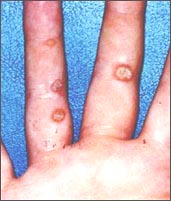
사진 430. 손가락, 손 바닥에 난 보통 사마귀
Copyright ⓒ 2012 John Sangwon Lee, MD., FAAP
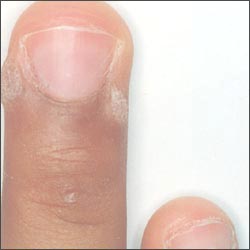
사진 429. 손톱 주위에 난 보통 사마귀
Copyright ⓒ 2012 John Sangwon Lee, MD., FAAP
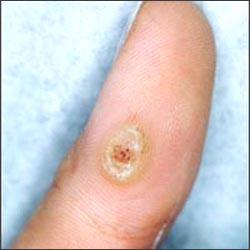
사진 428. 손가락과 손에 난 보통 사마귀
Copyright ⓒ 2012 John Sangwon Lee, MD., FAAP

사진 430. 손등에 난 보통 사마귀
Copyright ⓒ 2012 John Sangwon Lee, MD., FAAP
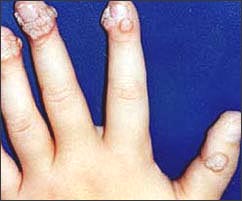
사진 431. 손가락과 손톱 주위에 난 보통 사마귀(조갑주위 우췌)
Copyright ⓒ 2012 John Sangwon Lee, MD., FAAP

사진432. 손가락과 손에 난 보통 사마귀
Copyright ⓒ 2012 John Sangwon Lee, MD., FAAP
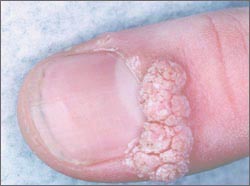
사진 433. 손톱 주위에 난 보통 사마귀(조갑주위 우췌)
사진 429와 비교할 때 모양에 비슷한 점이 있다.
Copyright ⓒ 2012 John Sangwon Lee, MD., FAAP
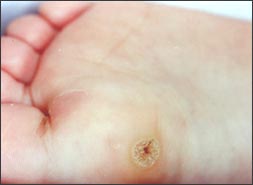
사진 434. 발바닥에 난 족저 사마귀(족저우췌)
Copyright ⓒ 2012 John Sangwon Lee, MD., FAAP

사진 435. 손등에 난 보통 사마귀
Copyright ⓒ 2012 John Sangwon Lee, MD., FAAP
보통 사마귀(심상성 사마귀)의 치료
- 보통 사마귀의 50%는 치료 없이 2~7년 이내 자연히 없어진다.
- 다른 문헌에 의하면(The Johns Hopkins Hospital, The Harriet Lane Handbook, 18th edition p.277)
- 보통 사마귀의 75%는 아무 치료를 해주지 않아도 3년 이내 자연히 없어진다.
- 외관상으로 보기 흉하든지, 사마귀가 난 부위가 아프면 의사에게 문의해 치료받는다.
- 보통 사마귀를 일으킨 바이러스에 의학적으로 아무 영향을 줄 수는 없다고 생각하는 바세린이나 어떤 종류의 크림 등을 한두 달 동안 발라 치료하든지, 암시 요법 치료를 하면 보통 사마귀의 30%가 자연히 치료된다.
- 비타민 C와 판터텐산 연고를 1일 2회 한두 달 정도 발라 치료해도 보통 사마귀의 30%가 치료된다.
- 그 이유는 확실히 모른다.
- 전기소작 치료, 레이저 치료, 냉동요법 치료, 화학약물 치료, 외과적 수술 절제 치료법 등으로 치료할 수 있다.
- 그렇지만 이런 적극적 치료 방법으로 치료할 때는 아프고 치료 후 흉터가 생길 수 있고 치료비가 많이 든다.
- 두오필름 액이나 오클로사 사마귀 치료약을 의사의 처방 없이 약국 OTC에서 사서, 1일 1~2회, 1~6주 동안 발라주면 사마귀가 점점 쪼그라진다. 쪼그라진 보통 사마귀의 일부를 둔한 수술칼날로 매일 살살 긁어 치료하면 사마귀 전체가 빠져 나올 수 있다.
- 앞에 설명한 여러 종류의 보통 사마귀 치료 방법으로 보통 사마귀를 치료하면 잠시 동안 전부 없어질 수 있지만, 그 중 30% 정도는 재발된다.
- 이미 언급 한 바와 같이, 치료를 하든 않든 보통 사마귀는 1~7년 이내에 자연적으로 다 없어진다.
- 최근 연구에 의하면 덕 테이프(Duck tape)로 치료하면 탁월한 효과가 나타난다고 한다. 그러나 2008년에 덕 테이프 치료 효과가 없다고 한다.
- 피부층 Bleomycin 주입치료도 한다.
- 접촉성 감각제, 병소내 피부검사 항원치료, 국소용 Imiquimod 크림 등으로 면역 치료도 한다..
- Cimetidine 경구투여 치료도 하나 별 효과가 없다는 연구도 있다. 출처; The Johns Hopkins Hospital, The Harriet Lane
- Handbook, 18th edition
Common warts (Verruca vulgaris)
Overview of common warts
• Of the many types of warts, the most common wart is the common wart.
• Warts usually appear on the face, hands, fingers, around nails, toes, elbows, and knees.
• A common mantis is the size of a millet or the size of a soybean pea.
• Larger warts are several centimeters in diameter.
• Common warts are viral infections of the skin.
• Common warts are also called warts vulgaris.
Symptoms, signs of common warts
• Symptoms vary depending on the skin area where the warts are located, the number of common warts, and whether or not there are complications.
• You may experience pain around the wart on the nail or the sole of the foot.
• Most common warts on other parts of the body are unsightly and show no symptoms, but they can be harsh and a little itchy. • You can usually self-infect the virus that causes warts. Usually, warts can fly linearly, several can fly in a cluster on one site, there can be only one, and they can fly in the form of plaques.
• Usually, the wart can be a little sore if you bite it off with your fingernails or rub the wart somewhere. • Bacterial infections on warts can cause sores on and around the wart.
• Usually, when a wart occurs around the nail, the boundary between the edge of the wart and the normal skin around it is not clear, and it can grow under the nail and cause pain under the nail. These warts are called peri-nail warts or peri-nail warts. • If you have warts on the soles of your feet, the area on the soles of your feet may hurt.
• The sole of the foot may hurt when walking, especially when walking on a wart-bearing foot because the wart mass compresses the peripheral nerves of the foot under the layer of skin just below the wart on the sole of the foot.
• These warts on the soles of the feet are called plantar warts or plantar warts and are different from common warts.
• Usually, the virus that causes warts does not enter the bloodstream and cause no disease in other parts of the body.
• Common warts can come in direct contact with surrounding skin and spread to the surrounding skin, causing self-infection and new common warts.

Picture 435. Common wart on the back of the hand Copyright ⓒ 2012 John Sangwon Lee, MD., FAAP

Picture 430. Common warts on the palms of the fingers and hands Copyright ⓒ 2012 John Sangwon Lee, MD., FAAP

Picture 429. Common warts around the nails Copyright ⓒ 2012 John Sangwon Lee, MD., FAAP

Picture 428. Common warts on fingers and hands Copyright ⓒ 2012 John Sangwon Lee, MD., FAAP

Picture 430. Common wart on the back of the hand Copyright ⓒ 2012 John Sangwon Lee, MD., FAAP

Picture 431. Common warts around fingers and nails Copyright ⓒ 2012 John Sangwon Lee, MD., FAAP

Picture 432. Common warts on fingers and hands Copyright ⓒ 2012 John Sangwon Lee, MD., FAAP

Picture 433. Normal wart around the nail Compared to Photo 429, there are similarities in shape. Copyright ⓒ 2012 John Sangwon Lee, MD., FAAP

Picture 434. Plantar wart on the sole of the foot Copyright ⓒ 2012 John Sangwon Lee, MD., FAAP

Picture 435. Common wart on the back of the hand Copyright ⓒ 2012 John Sangwon Lee, MD., FAAP
Treatment of common warts
• Usually 50% of warts go away on their own within 2-7 years without treatment.
• According to other literature (The Johns Hopkins Hospital, The Harriet Lane Handbook, 18th edition p.277)
• In general, 75% of warts will go away spontaneously within 3 years without any treatment.
• If the wart is painful or unsightly, see your doctor for treatment.
• Usually 30% of warts are cured spontaneously with suggestive therapy, whether treated with Vaseline or some kind of cream for a month or two, which is thought to have no medical effect on the virus that causes warts.
• Even if you apply vitamin C and pantothenic acid ointment twice a day for a month or two, 30% of warts are usually cured.
• Not sure why.
• It can be treated with electrocautery treatment, laser treatment, cryotherapy treatment, chemical drug treatment, and surgical excision treatment.
• However, when treated with this active treatment method, it can be painful, scarring after treatment, and costly.
• If you buy Doofilm solution or Oclosa wart treatment at a pharmacy OTC without a doctor’s prescription and apply it 1~2 times a day for 1~6 weeks, the wart will gradually shrink. The entire wart can be removed by gently scraping a small portion of the wart every day with a dull surgical blade.
• Treatment of common warts with the different types of common warts described above can go away for a while, but about 30% of them recur.
• As already mentioned, with or without treatment, warts usually disappear spontaneously within 1 to 7 years.
• According to a recent study, treatment with duck tape shows an excellent effect. However, in 2008, it was reported that the duck tape treatment had no effect.
• Skin layer Bleomycin injection treatment is also performed.
• Immunotherapy with contact sensory agents, intralesional skin test antigen therapy, topical Imiquimod cream, etc.
• There is also a study showing that oral cimetidine treatment has no effect. source; The Johns Hopkins Hospital, The Harriet Lane • Handbook, 18th edition
출처 및 참조 문헌 Sources and references
- NelsonTextbook of Pediatrics 22ND Ed
- The Harriet Lane Handbook 22ND Ed
- Growth and development of the children
- Red Book 32nd Ed 2021-2024
- Neonatal Resuscitation, American Academy of Pediatrics
-
소아가정간호백과–부모도 반의사가 되어야 한다, 이상원
-
The Johns Hopkins Hospital, The Harriet Lane Handbook, 18th edition
-
Red book 29th edition 2012
-
Nelson Text Book of Pediatrics 19th Edition
-
Infectious disease of children, Saul Krugman, Samuel L Katz, Ann A. Gerhon, Catherine Wilfert
-
제16권 소아청소년 피부 질환 참조문헌 및 출처
-
Emergency Care Transportation of Sick and Injured American Academy of Orthopaedic Surgeons
-
Emergency Pediatrics A Guide to Ambulatory Care, Roger M. Barkin, Peter Rosen
-
Rheumatic fever Angelo Taranta, Milton Markowitz
-
Rheumatic fever Milton Markowitz and Gordis
-
Pediatric orthopedics Tachdjan
-
Gray’s Anatomy
-
Diseases of The Skin in Children and Adolescents by G. W. Korting
-
A Manual of Dermatology, Pillsbury
-
Clinical Pediatrics Dermatology, A Textbook of Disorders of Childhood Adolescence, Sidney Hurwitz
-
Manual of Skin Diseases, Gordon C. Sauer
-
Pediatric annals October 2010
-
의학 용어사전 대한 의사 협회
-
그 외
Copyright ⓒ 2014 John Sangwon Lee, MD., FAAP
“부모도 반의사가 되어야 한다”-내용은 여러분들의 의사로부터 얻은 정보와 진료를 대신할 수 없습니다.
“The information contained in this publication should not be used as a substitute for the medical care and advice of your doctor. There may be variations in treatment that your doctor may recommend based on individual facts and circumstances.
“Parental education is the best medicine.